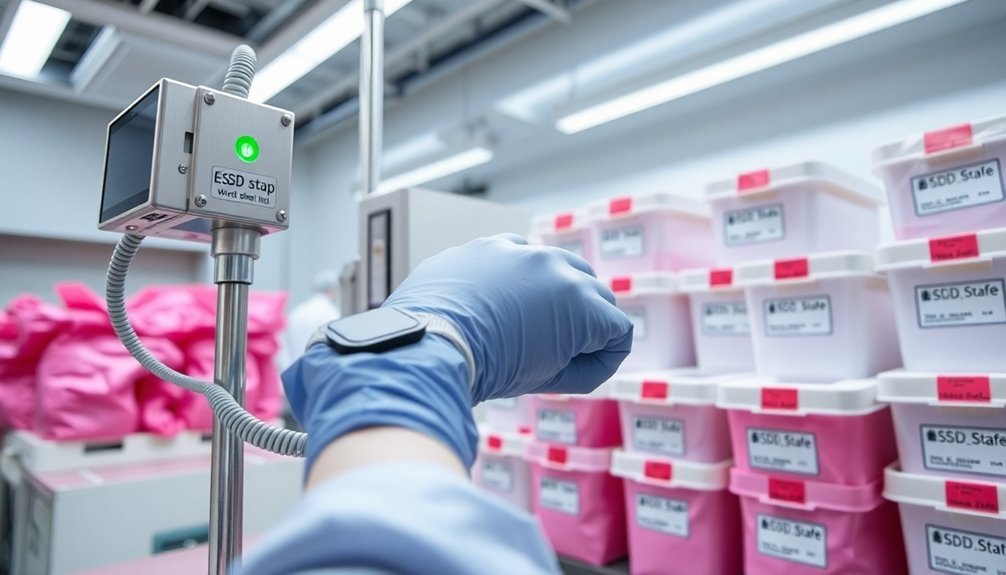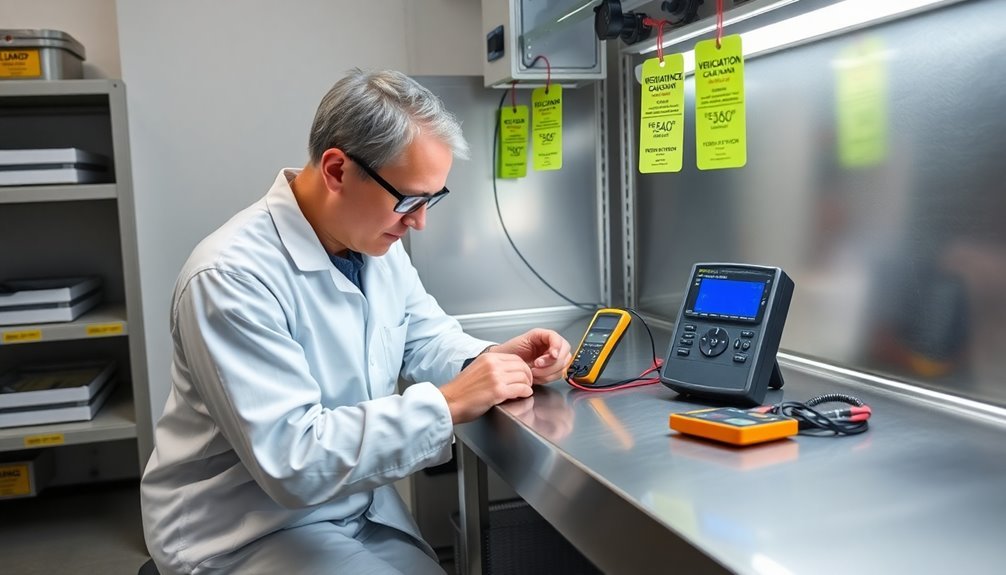To fix ESD control audit issues, you'll need to focus on seven key areas. Start by implementing daily equipment testing with proper verification tools and logs. Next, upgrade your ESD training programs to include both hands-on and computer-based learning. Maintain thorough documentation procedures and establish clear audit schedules for compliance tracking. Enhance your workstation grounding methods through extensive system design. Strengthen material control standards to meet ANSI/ESD S20.20 requirements. Create efficient corrective action systems with management engagement. Finally, optimize your feedback mechanisms to guarantee continuous improvement. These foundational steps will set you up for a deeper understanding of ESD control excellence.
Implement Daily Equipment Testing

Three essential daily tests form the foundation of effective ESD control: wrist strap checks, footwear testing, and continuous monitoring verification. You'll need to perform these tests while wearing your ESD protective equipment and log all results to maintain process effectiveness.
Using a thorough testing approach helps you identify potential issues before they lead to costly damage. Sampling and frequency adjustments should be based on consistent test results over time.
To properly test your equipment, you'll want to use specific measurement tools. The surface resistance megohmmeter helps you conduct RTT and RTG tests, while the Ground Pro Meter confirms ground impedance.
For more detailed monitoring, the Iron Man Plus Workstation Monitor provides complete ESD coverage, and tools like the ESD Pro Indicator and EM Eye Meter help you detect ESD events as they occur.
Make sure you're following your compliance verification plan's specific testing frequencies. While you'll perform wrist strap and footwear checks daily, other elements like floor testing may require less frequent verification.
If you're using ESD floor finishes, you might need more frequent monitoring due to their temporary nature. Remember to maintain detailed logs of all your daily testing activities to demonstrate consistent ESD control compliance.
Upgrade ESD Training Programs
Maintaining an effective ESD control program requires thorough training that evolves with your facility's needs.
You'll need to implement a blended approach that combines instructor-led sessions with computer-based training, which can reduce total training time by 50% while improving retention rates. Studies show that companies incorporating this training model achieve perfect scores in ESD symposium evaluations.
Start by customizing your training programs to address specific ESD control requirements. Include both basic operator training and advanced topics like CDM and Class 0 handling.
Make sure you're incorporating industry standards such as ANSI/ESD S20.20 and IEC 61340-5-1 into your curriculum. Don't forget to provide role-specific training that clearly outlines each person's responsibilities in the ESD Control Program Plan.
Enhance learning through hands-on demonstrations and assessments on your manufacturing floor. Use a variety of training tools, including videos, interactive computer programs, and visual aids like bulletin boards and posters.
Set up a central repository for ESD educational materials that employees can access for reference. Most importantly, establish regular retraining schedules and implement feedback mechanisms to measure program effectiveness.
Track compliance through regular audits and use the findings to drive continuous improvement in your training program.
Review Documentation Procedures

Properly storing your ESD control documentation in a centralized, easily accessible system helps you maintain compliance and quickly address potential issues.
Regular audits should be scheduled and documented to verify ongoing effectiveness of your ESD control measures.
You'll need to establish clear filing protocols for both physical and digital documents, including maintenance records, calibration certificates, and audit reports.
Organizing your ESD checklists by frequency (daily, weekly, monthly) and area of responsibility streamlines your quality control process and guarantees consistent monitoring of your ESD control program.
Document Storage Standards
Through effective document storage standards, you'll create a foundation for maintaining a reliable ESD control program. Implement a centralized storage system that guarantees your team can access documents quickly while maintaining strict security protocols. You'll need to establish version control measures to prevent the use of outdated procedures and maintain clear revision histories. Regular compliance verification audits must be conducted according to the required verification plan frequency. Don't forget to implement clear labeling conventions using standardized templates and proper indexing. You'll want to establish a regular audit schedule to verify compliance with ESD standards and maintain proper documentation. Make sure you're using encryption for sensitive files and keeping detailed access logs. When you update documents, send notifications to relevant team members and maintain a thorough revision history that tracks all changes and approvals.
| Storage Requirement | Implementation | Benefit |
|---|---|---|
| Centralized System | Cloud or network drive | Quick access for all authorized users |
| Version Control | Automated tracking software | Prevents use of outdated documents |
| Security Measures | Encryption and access logs | Protects sensitive information |
| Backup Protocol | Regular automated backups | Guarantees data recovery capability |
| Format Standards | Multiple file formats | Accommodates various user needs |
ESD Checklist Organization
A well-organized ESD checklist system serves as the cornerstone of your documentation procedures. You'll need to develop thorough checklists that align with ESD control specifications and ISO 9000 requirements while addressing your program's specific needs.
Make sure your checklists include standardized formats that match ESD Association certification requirements. Your checklist content should cover all critical ESD control elements, including personnel practices, equipment grounding, and protective measures. The controlled document plan must be approved by management before implementation.
You'll want to incorporate questions that verify compliance with ANSI/ESD S20.20 standards and evaluate adherence to industry regulations. Don't forget to assess your facility's unique requirements and include relevant checkpoints.
Keep your checklists current by reviewing them against existing ESD control procedures. You should update them whenever there are changes in control measures or standards.
Implement your checklists through regular compliance audits, typically conducted monthly, using consistent sampling techniques and statistical analysis. Document all findings and recommendations thoroughly.
This systematic approach helps you identify non-conformities quickly and prioritize corrective actions effectively. Remember to maintain detailed records of your audit results to track improvements and demonstrate compliance over time.
Enhance Workstation Grounding Methods
You'll need to establish a thorough grounding system design that connects all workstation elements to a common point ground while maintaining proper resistance levels.
Every grounding point must maintain resistance of 1-10 megohms to ensure effective charge dissipation throughout the protected area.
Start by implementing daily ground path tests to verify the integrity of wrist straps, work surfaces, and floor mats using calibrated testing equipment.
Follow ground continuity verification steps meticulously, checking connections between your grounding cords, auxiliary grounds, and the main ESD ground bus bar to guarantee complete protection of sensitive components.
Daily Ground Path Tests
Effective ground path testing forms the backbone of any reliable ESD control system. To maintain your ESD protection standards, you'll need to implement daily testing procedures using ground-resistance testers for accurate measurements. Start by checking the resistance between your auxiliary earth ground and AC system's ground conductor, guaranteeing all grounding points connect to a common point ground.
You'll want to test your wrist straps daily if they're frequently used, and verify that your ESD worksurface mats are properly connected to ground. Don't forget to inspect the integrity of all grounding connections, including metallic crimps, snaps, and banana plugs. Use a ground-integrity monitor to guarantee continuous grounding throughout your workday. Consider having independent lab testing performed periodically to ensure unbiased verification of your grounding system.
Make sure you're regularly testing foot grounders when they're used with ESD flooring, as they provide an essential path-to-ground for personnel. You should also employ static locators or specialized grounding test equipment for periodic verification.
If you find any issues during testing, replace the affected grounding devices immediately. Remember to document all your test results and maintain a regular cleaning schedule for your ESD equipment to preserve its effectiveness.
Comprehensive Grounding System Design
Building upon daily testing protocols, a well-designed grounding system serves as the foundation for complete ESD protection. You'll need to establish a common point ground and connect all ESD control elements to this single point. This systematic approach guarantees consistent charge dissipation and prevents potential differences between equipment. Maintaining resistance to ground of less than 1 megohm ensures optimal protection.
To implement an effective grounding system, you'll want to focus on these critical components:
- Install wrist strap grounding systems beneath bench tops and connect them to your common point ground, guaranteeing operators have easy access while maintaining system integrity.
- Integrate ESD-compatible furniture with proper grounding cords for worksurfaces and floor mats, creating a seamless ground path.
- Set up flooring and footwear systems for mobile operations, complementing seated workstation protection with wrist straps.
You'll need to verify that all conductive surfaces are properly connected and maintain regular evaluations of your grounding system's effectiveness.
When designing your system, make sure you're following ANSI/ESD S20.20 standards and using appropriate grounding cords for each component.
Don't forget to implement constant monitoring systems where critical operations occur to maintain continuous protection against ESD events.
Ground Continuity Verification Steps
Three essential ground continuity verification methods guarantee your ESD workstation maintains proper protection levels. Start with stakeless testing using dual clamps or a specialized device like the 1630-2 FC to eliminate the need for ground stakes and reduce testing time. Next, implement selective testing with one clamp and two stakes positioned 20 meters apart to isolate specific installation components and measure individual earth electrodes accurately.
| Testing Component | Verification Action |
|---|---|
| Ground Bond | Load connection with high current to verify integrity |
| Continuity | Quick check for existing connections |
| Worksurface Mat | Connect grounding cord firmly to studs and ground |
| Floor Systems | Test conductivity with ESD control footwear |
| Wrist Straps | Verify proper connection to common ground point |
Don't forget to perform fall of potential measurements using two stakes and your test electrode to verify correct installation. You'll need to disconnect the ground electrode and use a device like the Fluke 1625-2 to generate current and measure voltage drops. Remember to maintain firm-fitting connecting devices and avoid temporary solutions like alligator clips that can compromise your grounding system's reliability.
Strengthen Material Control Standards

Modern ESD control requires robust material control standards that align with ANSI/ESD S20.20-1999 specifications.
You'll need to establish thorough material procurement, handling, and storage procedures that guarantee consistent ESD protection throughout your facility.
Focus on implementing strict guidelines for ESD-safe materials, including proper packaging, trash holders, and cleaning supplies while maintaining detailed compliance records.
To strengthen your material control standards, verify you're following these critical elements:
- Verify all materials meet ANSI/ESD S20.20 requirements through regular testing and maintain detailed procurement specifications for ESD-safe materials
- Implement strict EPA protocols with clear identification, protection measures, and continuous monitoring of ESD control equipment
- Document all procedures thoroughly and conduct regular training sessions for personnel handling sensitive components
You should regularly audit your material control system for non-compliant materials and implement immediate corrective actions when issues arise.
Don't forget to prohibit insulating materials like silicon, soap, and mineral oil in your cleaning supplies.
Store all documentation in dissipative holders or binders, and maintain thorough records of material compliance and EPA monitoring results to guarantee continuous improvement of your ESD control program.
Establish Clear Audit Schedules
A well-structured audit schedule forms the backbone of an effective ESD control program. You'll need to implement different audit frequencies for various ESD control elements, from daily checks to annual assessments. Start with monthly audits for each department, then adjust based on performance and compliance trends.
| Frequency | Required Checks |
|---|---|
| Daily | Wrist straps, footwear, smocks |
| Weekly | Workstations, floor mats, ground connections |
| Monthly | Static surveys, smock electrical tests |
| Quarterly | RTG testing, ground continuity checks |
| Annual | Ionizer balance, system compliance |
You'll want to maintain detailed records of all audit results to track trends and identify areas needing improvement. If you're finding consistent problems in certain areas, increase the audit frequency there. Conversely, you can reduce frequency in areas showing sustained compliance. Remember to base your sampling technique on work areas rather than individual workstations, making your audits more efficient. When implementing corrective actions, don't wait for the next scheduled audit – address issues immediately and document your responses. This proactive approach helps maintain ISO-9000 compliance while ensuring your ESD control program remains effective.
Optimize Corrective Action Systems

Regular audits only work when paired with an effective corrective action system. You'll need to categorize findings into observations, minor non-conformances, and major non-conformances to prioritize your response effectively. Track trends through statistical analysis and detailed reports to identify recurring issues that require immediate attention.
When implementing corrections, focus on these vital components:
- Establish a feedback loop that monitors the effectiveness of each corrective action
- Combine instructor-led and computer-based training to address knowledge gaps
- Implement statistical process control to trigger adjustments when deviations occur
Your corrective action system should include process adjustments, facility modifications, and documentation updates as needed.
Don't forget to retrain employees when audits reveal knowledge gaps or procedural misunderstandings. Keep detailed records and trend charts to evaluate the effectiveness of your corrective measures over time.
Remember to engage management in the process, as their commitment is essential for maintaining continuous improvement. Regular evaluation of your corrective actions through follow-up audits will guarantee that implemented solutions actually fix the identified problems and prevent their recurrence.
Frequently Asked Questions
How Often Should ESD Protective Materials Be Replaced?
You'll need to replace ESD materials based on testing results and type: weekly for workstation checks, monthly for smocks, and annually for system compliance. Most dissipative materials last 12 months to 3 years.
What Humidity Levels Are Optimal for ESD Control?
You'll want to maintain relative humidity between 40% and 60% for ideal ESD control. Don't let it drop below 30% RH, as this increases static discharge risk. Higher humidity helps dissipate static charges naturally.
Can Regular Office Furniture Be Modified for ESD Protection?
Yes, you can modify regular office furniture for ESD protection by applying conductive coatings, installing grounding systems, and adding ESD mats. However, you'll need to regularly test and maintain these modifications for effectiveness.
How Do Seasonal Changes Affect ESD Control Effectiveness?
During winter, you'll notice decreased humidity greatly increases ESD risks. You need to monitor humidity levels closely, as they'll affect your ESD control materials' performance. Maintaining 40-70% relative humidity helps prevent ESD issues.
When Should Third-Party ESD Auditors Be Brought In?
You'll need third-party ESD auditors when you're setting up a new program, making major facility changes, preparing for certification, encountering recurring issues, or requiring annual compliance verification. They provide unbiased, expert assessment.
In Summary
You'll find these seven ESD control solutions critical for maintaining your facility's compliance and protecting sensitive components. By implementing rigorous testing, upgrading training, and strengthening your standards, you're building a robust ESD program that'll stand up to audits. Don't wait for audit failures to make changes – take proactive steps now to guarantee your ESD controls meet or exceed industry requirements.





Leave a Reply